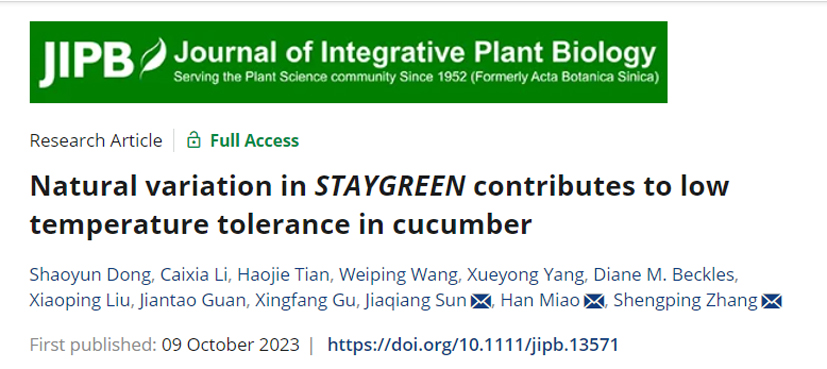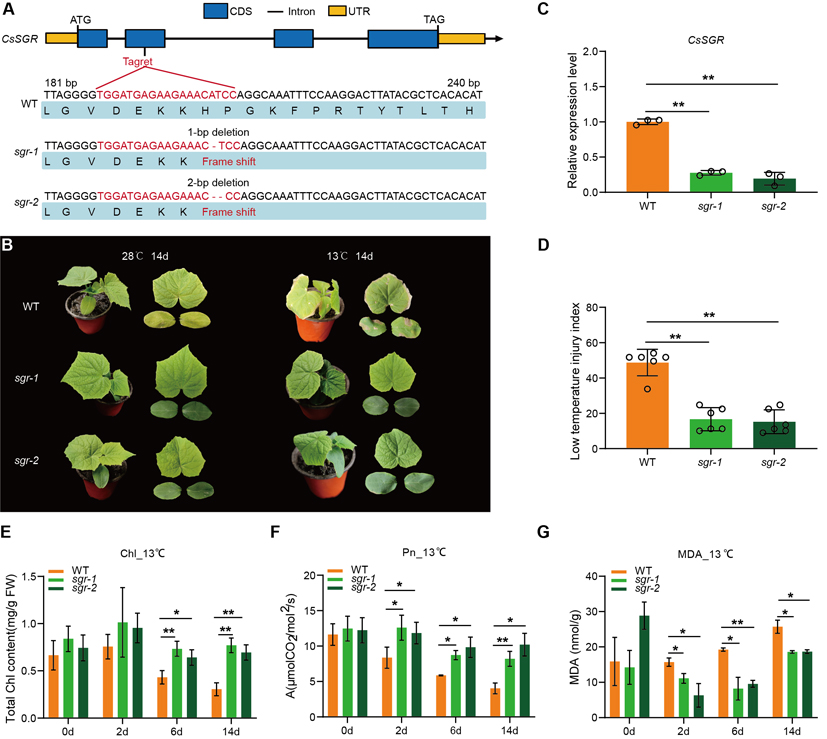Recently, Cucurbitaceae Vegetable Genetics and Breeding Group in the Institute of Vegetables and Flowers (IVF, CAAS) made important progress in molecular mechanism of low temperature (LT) tolerance in cucumber. The SNP323 in CsSGR was a functional locus effecting protein fuction and cucumber LT tolerance, and the LT-tolerant CsSGRHapG was selected in cucumber accessions from high latitudes, potentially contributing to LT tolerance during cucumber adaptation in cold regions. The paper was published in Journal of Integrative Plant Biology (IF=11.4) with the title of “Natural variation in STAYGREEN contributes to low temperature tolerance in cucumber”.

LT stress threatens cucumber production globally, however, the molecular mechanism underlying LT tolerance in cucumber remain largely unknown. In this study, using a genome wide association study (GWAS), a naturally occurring SNP in the STAYGREEN (CsSGR) at the gLTT5.1 locus that associated with LT tolerance was detected. The 155 accessions carrying the CsSGRHapA allele had significantly higher LT injury index than those with the CsSGRHapG allele, and all accessions carrying the CsSGRHapG allele showed LT tolerant phenotype. Knockout mutants of CsSGR generated by CRISPR/Cas9 exhibit enhanced LT tolerance, in particularly, increased chlorophyll content and reduced ROS accumulation in response to LT. Moreover, the C-repeat Binding Factor 1 (CsCBF1) transcription factor can directly activate the expression of CsSGR. The LT-sensitive haplotype CsSGRHapA, but not the LT-tolerant haplotype CsSGRHapG could interact with NON-YELLOW COLORING 1 (CsNYC1) to mediate chlorophyll degradation. Geographic distribution of the CsSGR haplotypes indicated that the CsSGRHapG was selected in cucumber accessions from high latitudes, potentially contributing to LT tolerance during cucumber cold-adaptation in these regions. CsSGR mutants also showed enhanced tolerance to salinity, water-deficit, and Pseudoperonospora cubensis, thus CsSGR is an elite target gene for breeding cucumber varieties with broad-spectrum stress tolerance. Collectively, the findings provide new insights into LT tolerance and will ultimately facilitate cucumber molecular breeding.

Figure 1. CRISPR/Cas9 mutants reveal the in vivo role of CsSGR in LT tolerance

Figure 2. A proposed working model for the CsSGR-mediated LT response in cucumber
This study was led by groups from IVF-CAAS, Prof. Zhang Shengping, Associate Prof. Miao Han, and Prof. Sun Jiaqiang are co-corresponding authors. Associate Prof. Dong Shaoyun, Li Caixia, and Tian Haojie contributed equally to this work as co-first authors. This work was funded by the National Natural Science Foundation of China, the Earmarked Fund for Modern Agro-industry Technology Research System, Science and Technology Innovation Program of the Chinese Academy of Agricultural Science.
Link to this paper: https://doi.org/10.1111/jipb.13571
By Shaoyun Dong (dongshaoyun@caas.cn)